With Sector 1 conquered, there’s not much doubt about where to go next. Adam tells you to head to Sector 2; all the other sectors are closed off; and the hub area flashes the “2” marking in the background to eliminate any ambiguity that might remain.
You’re going to Sector 2 now, and that’s final.
All of this seems very suffocating, doesn’t it? Metroid Fusion refuses to leave you to your own devices, huh? How horrible!
In truth, Fusion is being no more linear at this point than Super Metroid. It’s just being a lot chattier about it — a lot more obvious. Instead of letting players figure out the fact that they can’t make any more progress in a given area on their own, Fusion simply tells you and says, “You’re done here, head on out.” I can understand why the designers would take this approach; the Miiverse shenanigans that resulted from Super Metroid‘s release on Virtual Console were surely just a tiny glimpse of the awful “Help, I’m stuck” messages that came in to Nintendo’s counselor phone lines and trickled back to the developers.
Is it the right approach? I’m not crazy about it, personally. There’s something to be said for figuring things on your own. But again, Fusion debuted in a different time than Super Metroid, with different expectations attached. Fusion strikes me less as a degradation of game design by its creators and more of a reaction to a changing medium and consumer base. The past is a country we can never go back to again.
And anyway, Fusion doesn’t hold your hand forever. Sector 1 and the main deck had several doors that demand your eventual return once you’re more properly equipped. And beginning with Sector 2, you’re given less explicit instructions and left to discover more of the area map on your own.
This is all of Sector 2 you’re shown initially, but the area actually spans about three times this much space. To complete this chapter, you’ll need to explore on your own, far removed from Adam’s supervision and guidance.
The game doesn’t tip you off to this fact, though. Instead, you’re introduced to a different factor: That other version of Samus is an X parasite that Adam has decided to designate as “SA-X,” and it can completely destroy you in an instant. This becomes Adam’s new refrain: You will die, you are helpless, fly you fool.
And a small story justification to the fact that every step of your journey will no longer be predefined for you: Internal security measures obscure certain data from being available to Adam and Samus, so you need to explore in order to reach your target: The security room that allows you to unlock blue doors.
This proves to be no real trouble at first; Sector 2’s initial area is pretty small and low in challenge, and there’s only one area that the “hidden” security room could really be.
The security room gives you access to the data room, where you gain access to Samus’ bomb power. As always, this works by rolling into a ball and “firing,” whereupon you plant a bomb that can damage enemies, break through walls, and give Samus a small boost with its explosive force. Unlike in previous games, the propulsion doesn’t stack — you can’t “bomb jump” as in previous games. This actually comes off as a more aggressive attempt to restrict player actions and force linear play than the communication rooms, as it prevents sequence breaking.
Once you acquire Bombs, you’ll hear a loud explosion and find that the door to the rest of the sector has been destroyed; another near-miss with the SA-X that forces you to find another route.
Not surprisingly, this route can be cleared with the use of bombs to blast through certain vulnerable blocks.
The creatures (or parasitic mockeries thereof) inhabiting the tropical zone appear to be big honkin’ insects from previous games: Sidehoppers, Reos, and these grub-things that resemble Ohmu. Though the grubs are easy enough to destroy, they’ll surprise you from time to time; occasionally, grub parasites left to float free will coalesce into much more powerful blue versions of the grubs that move quickly and soak up a ton of damage.
This particular nook serves as both a trap to reveal that feature and a reinforcement of the fact that you need to bomb certain passages in order to advance. The ceiling above crumbles beneath your feet as you pass overhead (then immediately reseals), pinning you in a small room with parasites, and the only exit is to bomb the conduit to the right clear of blockage.
Another new element here are the hidden columns that rise out of seemingly random sections of floor when bombed. These allow you to pass over otherwise impossible obstacles, though they seem haphazardly placed and generally fairly useless.
The flood region is patrolled by fish that demonstrate the same clustering behavior as the grub parasites: If you don’t snatch the free parasites from the little fish, they become a big fish that’s invulnerable to standard cannon fire and hits Samus for nearly an entire energy tank’s worth of damage. Because you move more slowly underwater, the parasites have more time to group up and cause trouble, so this can be a nasty surprise.
The closer you come to the region’s boss, the more the scenery changes. The tropical forest becomes a mold-ridden mess (seemingly another allusion to Nausicäa).
Unsurprisingly, at the heart of this sea of corruption you’ll find another eye-door… though you can’t reach if from the most obvious entry point. Your bombs do nothing here, and you’re forced to find another way around. At this point, you haven’t communicated with Adam since entering the tropical zone, and you’ve explored far more of Sector 2 than originally mapped out — and, for the moment, you’re trapped down here, as the exits located upward are too high up for you to reach with Samus’ current power set.
Near the boss you’ll also find this uncharacteristically useless room. There are no secrets hidden here, even though you can shoot loose the ceiling and jump up into the alcove above. How odd!
Eventually, you have to work your way around to the eye door by taking a circuitous route upward and approaching through the ceiling. This takes a bit of detective work and exploration, as the path isn’t really intuitive. You need to keep track of your objective on the map and sort out where other rooms are relative to the door. The level design of Fusion, while not precisely intricate at this point, is definitely growing more complex and expecting more of players.
The boss itself is a weird one — a column of gelatinous tubes topped by a big blue eye and a set of stalks that look like nothing so much as a shock of clown hair. It inches along the ground, leaping vigorously back and forth in a huge arc that’s easily ducked beneath.
The creature’s main form of attack is to stop in midair and open its maw-end wide to attempt to consume Samus. Metroid veterans might experience a moment of trouble here, since this most resembles the fight with the metroid queen at the end of the second game. But the goal here, despite how neatly a morphed Samus fits into the monster’s business end, is not to roll up into the thing at bomb its nucleus.
Instead, you need to stand your ground and pepper its guts with missiles while it’s descending. You have time to fire off two or three missiles as it drops before it comes too close and engulfs Samus. With each round you plaster its innards with explosives, it loses a segment of its body and begins moving slightly faster, because in video games mortally wounding a wild creature causes it to become more powerful rather than less.
Still, Samus’ new bomb power does come into play here. If you’re sucked up by the boss, you can escape in the classic Metroid fashion by ducking into a ball and laying down bombs until it releases you. As in Super Metroid, the game teaches you the importance of escaping a creature’s clutches with bomb by showing rather than telling quite early on. Of course, all the metroids in the galaxy are dead at this point, so obviously there’s no point in all of this, right?
The creature’s core is a lower-grade version than the last boss you fought; simply hitting it with missiles or charged beams will destroy it, and its only form of attack consists of floating back and forth and trying to bump into you.
Absorbing its essence restores two of Samus’ powers: The high-jump (allowing you more hangtime when you leap) and the jumpball (allowing you to hop while in morph ball form). Naturally, these are the keys to escaping Sector 2, so it’s a good thing this dude was hanging out here instead of the X that restores your Screw Attack or something.
These new powers work everywhere, including underwater, allowing you to pick up a power you couldn’t collect before.
This same room includes an overhead rail that you can also reach now that you’re able to jump higher, so there are two missile containers newly within your grasp in close proximity to one another, acquired through slightly different applications of your skills.
Fusion‘s world is much more dynamic than in previous games, constantly changing as you advance. Besides the havoc SA-X wreaks as she stomps through the station, you also have other shifting factors within the world. Once you defeat the eyeball tube guy, the grubs that had been skulking along the floors and walls enter a pupal phase of their lifecycle. They become harmless to the touch in this form, but also immovable.
This creates makeshift platforms to help Samus reach new areas in some cases and creates semi-permanent obstructions in others. It’s another way the designers arbitrarily control what players can and can’t access as Samus acquires new powers — certain areas that you’ll have to explore later are conveniently blocked off by these shifting larvae — but it’s far more elegant than Adam saying, “No, sorry, I’m closing the doors now.” Which he does from time to time. But this at least feels like something natural within the world as opposed to an outside force imposing limitations.
Speaking of outside forces, once you destroy the boss you’ll find the nearby exit has been demolished by more of the SA-X’s obscene powers, forcing you to find an alternate route…
…which leads you back to that “useless” room, where the upper alcove allows you your first direct glimpse of the SA-X in action. The music stops so that you hear nothing but the parasite’s heavy footsteps and the sound of its cannon fire. You can, if you’re very stupid, dash over to the right and shoot through the floor to take on the SA-X directly, but Adam wasn’t kidding. It will destroy you in an instant. On the plus side, it follows after a very easy boss fight, so if you want to see how efficiently SA-X can wipe you out you won’t have to recover too much hard-fought progress. On the other hand, you can simply wait and watch until it goes away on its own, then return to the entrance to Sector 2.
Whereupon you’ll find Adam defending his title as master of the obvious.
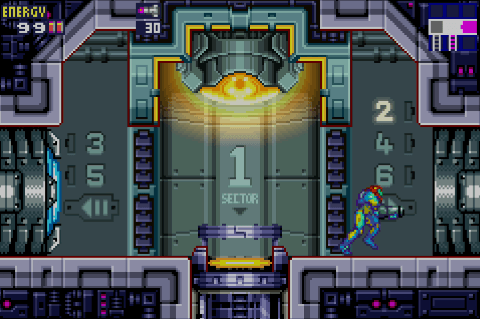

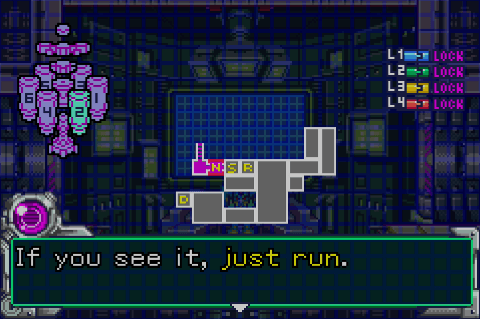

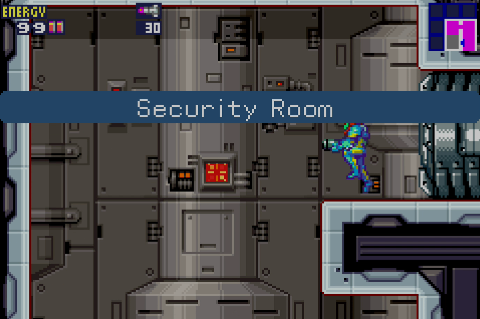
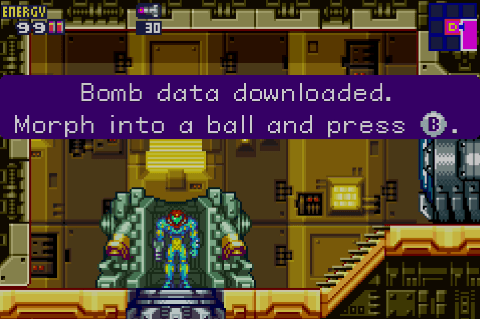


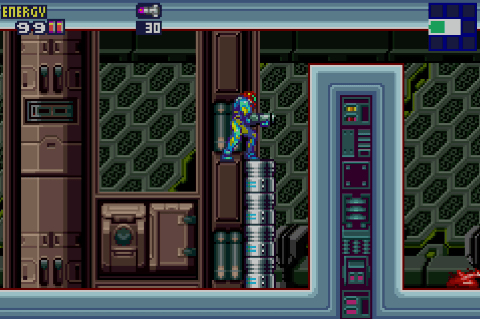
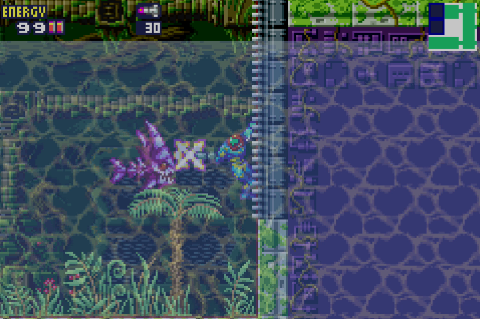
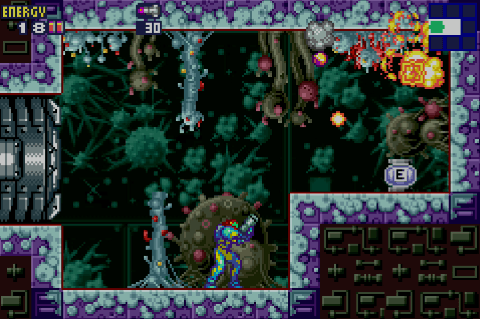
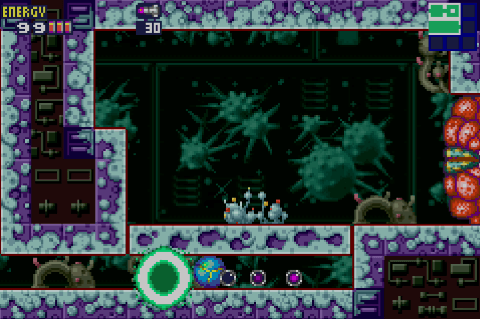
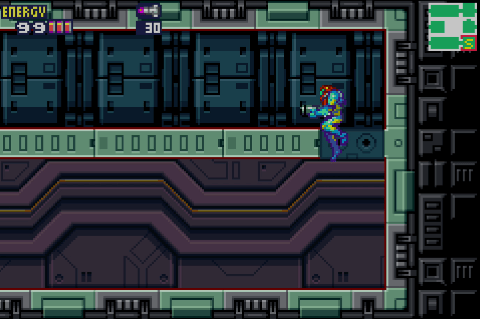
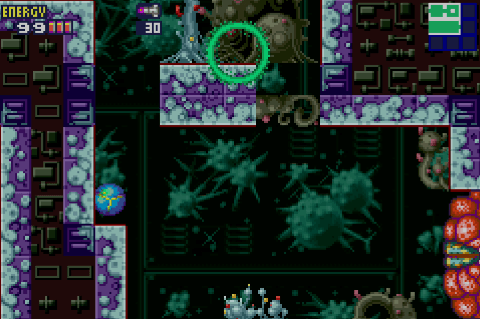

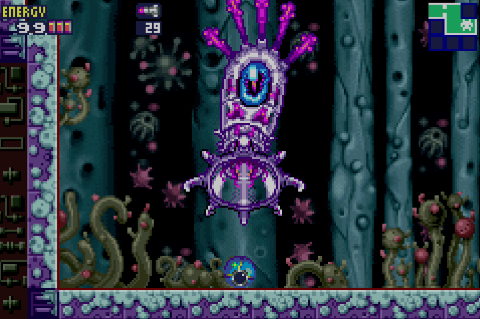

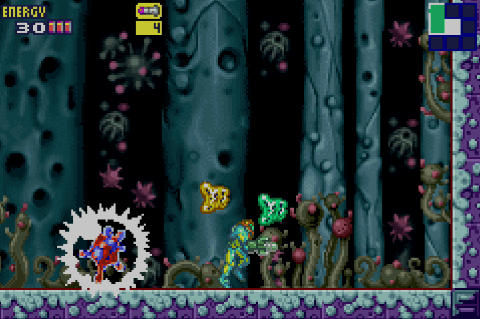


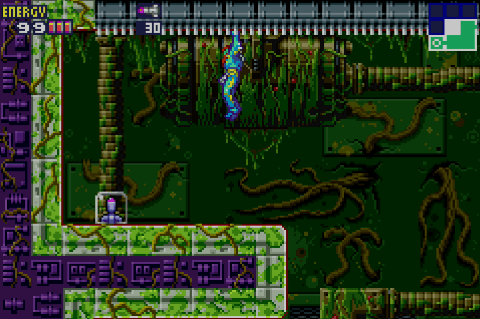

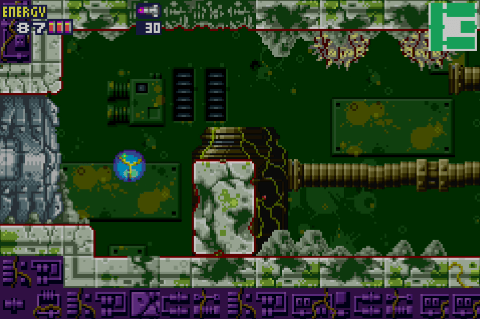
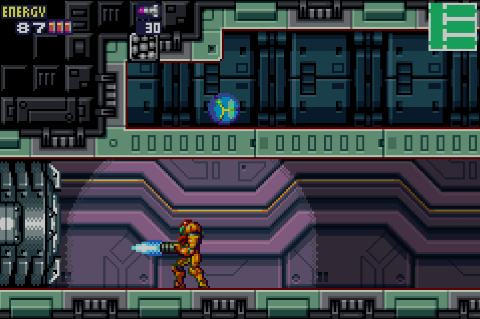
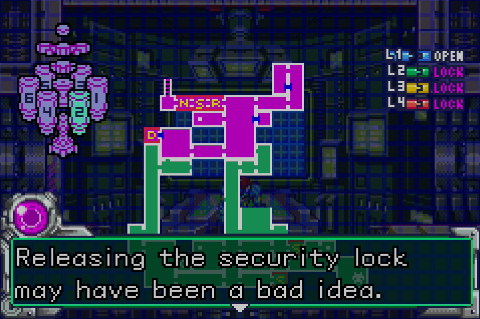
You have a point about Super Metroid being too hard for people, but it always struck me that the official player strategy guides were a great solution to that problem back in the day. Players could always get the book if they had trouble. And the guide for Super Metroid was absolutely beautiful.
In fact, nowadays, where there are FREE guides and walkthroughs all over the internet, I’d think that game developers should be a liberty to create challenging, non-linear levels. If a player gets stuck, it takes about 30 seconds on Google to find the solution.
Dark Souls and Minecraft are definitely testaments for that.
**spoiler**
I kinda like how the easiest of enemies turns into one of the thoughest (Kihunters pack a ton of damage in this installment).
I’m totally fine with doors being unlocked and pointed to with big glowing arrows when the time comes to move on to the next area, and I’m fine with the various gimmicks that force you to take a new route out than what you took in. It’s arbitrarily locking you out of, let’s call it like it is, the levels you’ve already completed, where I have a huge problem.
First off, if I missed some E-tanks and missiles on the first pass (because I suck), and hit a wall fighting some boss (because I suck), tough break, I just have to manage with a higher effective difficulty level than a more-skilled player would have.
Plus, the mechanical justification is they want you to do all your backtracking in one big push towards the end, but I know personally speaking, after the whole game training me that I was never allowed to backtrack, I completely missed the brief window where it was suddenly possible.
Which I suppose is timely enough here, where we’re accidentally evoking the Queen Metroid fight. That trick too, I never discovered, because why in the world would I suddenly think the mouth of this monster that keeps biting me is something I’d want to be in?
I always wondered if maybe the designers made Fusion so chatty and road-mappy because it was a portable game. Perhaps they figured people would play in short, irregular intervals and would have a hard time remembering what they were doing?
Anyway — thanks, Jeremy, these are so awesome!
It feels like it was, what, Metroid Prime 2 when they found a happy medium? It’s been awhile but IIRC that’s the one that let you flounder around on your own for awhile and THEN started giving you hints about where to go next. I prefer that to immediately pointing you at the next objective as soon as you complete the previous one.
Nah, Zero Mission is the perfect balance. We’ll look at that one next.
I’m looking forward to that one. Zero Mission is everything a Metroid game should be.